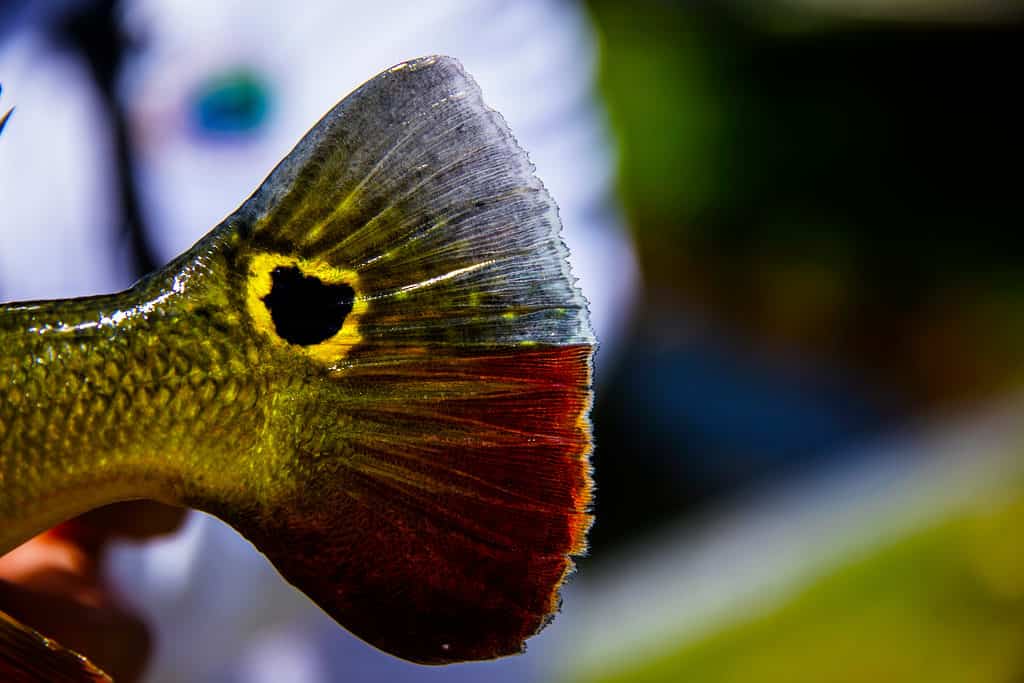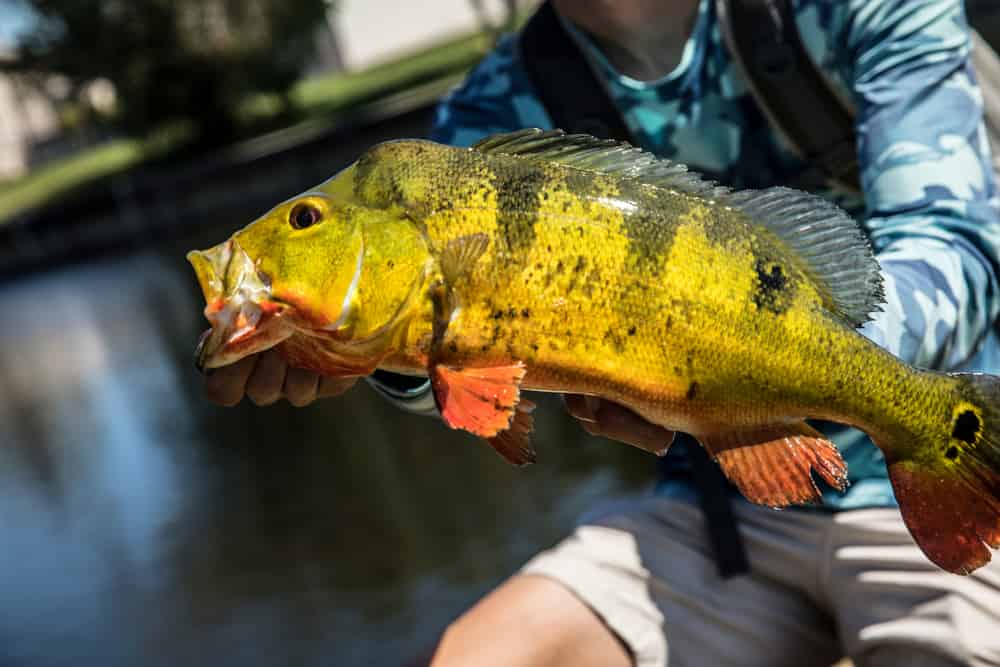Peacock Bass
Cichla ocellaris
Peacock bass is known for their aggressive behavior and predatory instincts, making them a challenging target for sport fishermen.
Advertisement
Peacock Bass Facts
- Main Prey
- smaller fish, crustaceans, and insects
- Name Of Young
- fry
- Group Behavior
- School
- Fun Fact
- Peacock bass is known for their aggressive behavior and predatory instincts, making them a challenging target for sport fishermen.
- Biggest Threat
- Habitat destruction
- Distinctive Feature
- Eye-like spots on their bodies
- Other Name(s)
- Pavón
- Average Spawn Size
- 50,000
- Lifestyle
- Diurnal
- School
- Origin
- Amazon and Orinoco basins, as well as rivers of the Guianas, in South America
Peacock Bass Physical Characteristics
- Color
- Brown
- Yellow
- Red
- Blue
- Black
- Green
- Orange
- Skin Type
- Scales
- Age of Sexual Maturity
- 12 months
- Aggression
- High
View all of the Peacock Bass images!
Peacock bass are tropical freshwater fish characterized by bright colors and eye-like spots on their caudal fin, as well as by overall aggressive behavior!
Peacock Bass Summary
The Peacock bass is a tropical freshwater fish native to South America, known for its bright colors and aggressive behavior, making it a popular target for sport fishing. The Peacock bass is commonly referred to as the “butterfly bass” or pavón, ‘peacock’ in Spanish. It can grow up to 20 inches and weigh up to 20 pounds. It is a predatory fish that feeds on smaller fish, crustaceans, and insects. With them highly prized as game fish, the Peacock bass is widely introduced in other countries for recreational fishing.
4 Peacock Bass Fun Facts
- Peacock bass uses acoustic communication, making sounds to communicate with other fish.
- These fish have been introduced in several countries outside their native range for sport fishing, including Florida and Hawaii.
- Peacock bass has vibrant and colorful markings on their bodies, which change depending on their mood and surroundings.
- Peacock bass display aggressive behavior and predatory instincts, making them a challenging target for sport fishermen.
Peacock Bass Classification and Scientific Name
The Peacock bass belongs to the family Cichlidae. Cichla ocellaris is the scientific name for the Peacock bass species. The Latin ocellaris stand for the distinct ocellated (eye-like) spots that Peacock bass show on their caudal fins.
However, taxonomic problems still exist since hybridization between Chicla specimens and regional variants throughout their extensive geographic distribution are pretty common. So, there are several species commonly referred to as Peacock bass, including:
- Cichla temensis (Speckled Peacock Bass)
- Cichla monoculus (Monoculus Peacock Bass)
- Cichla piquiti (Smallscale Peacock Bass)
- Cichla kelberi (Kelberi Peacock Bass)
- Cichla orinocensis (Orinoco Peacock Bass)
- Cichla vazzoleri (Vazzoler’s Peacock Bass)
These species vary in size, coloration, and behavior, with some species growing much more prominent than others.

Ocellated (eye-like) spots characterize the Peacock bass’s caudal fin. They make it look more aggressive, confusing potential predators.
©Kwanza Henderson/Shutterstock.com
Peacock Bass Appearance
The appearance of the Peacock bass is characterized by the following features.
- Bright colors. Peacock bass can range from green, blue, yellow, and brown to orange, red, and black. The coloration can change depending on the fish’s mood and surroundings.
- Colorful markings. These fish have vibrant and colorful markings on their bodies, including spots, stripes, and ocellated (eye-like) spots.
- Predatory look. Peacock bass has a distinctive predatory look with a large mouth and sharp teeth.
- Fusiform shape. They have a streamlined silhouette, which helps them swim quickly and maneuver easily in the water.
- Dorsal fin. They have a large, triangular dorsal fin, which helps them maintain stability when swimming.
- Variable size. Peacock bass can vary widely depending on the species, with some species growing up to 20 inches in length and weighing up to 20 pounds.

The Peacock bass has a distinctive predatory look with a large mouth and ocellated (eye-like) spots on its caudal fin.
©Kwanza Henderson/Shutterstock.com
Distribution, Population, and Habitat
- The Peacock bass is native to South America and primarily found in the Amazon Basin and Orinoco River. However, some species of Peacock bass have been introduced in other countries, including the United States, for sport fishing.
- Studies have shown that their population is stable in its native range. They form schools.
- Peacock bass is highly adaptable and located in various freshwater habitats, including rivers, lakes, and swamps. They prefer slow-moving waters with plenty of cover, such as vegetation and structure. They can also tolerate a wide range of water temperatures and pH levels.
Peacock Bass Predators and Prey
Peacock bass are aggressive predators. Their prey can include smaller fish, crustaceans, and insects. More prominent Peacock bass have few natural predators, but juvenile Peacock bass may fall prey to larger fish and birds. Juvenile Peacock bass feed on smaller prey, such as zooplankton and insects. Non-native species can also impact the Peacock bass population by preying on them or competing with them for food.
Peacock Bass Reproduction and Lifespan
Peacock Bass reproduce by spawning. Spawning occurs when the female lays her eggs in a shallow water area, and the male fertilizes them. After spawning, the eggs will hatch in about two days, where the fry will remain in the shoal water until they are large enough to swim in deeper water. Peacock bass can lay up to 50 000 eggs at a time, and the fry can grow to a size of 4 inches in just a few weeks. The fry will feed on small insects, bloodworms, and other tiny organisms until they are large enough to feed on larger prey. Their lifespan is approximately 8-10 years in the wild.
Peacock Bass Fishing and Cooking
To fish for Peacock bass, you should:
- Choose the right gear, such as a heavy spinning or baitcasting rod and reel.
- Use live or artificial baits that mimic prey, such as worms, crayfish, or spinnerbaits.
- Fish in shallow waters and around structures, such as rocks, logs, or weed beds where peacock bass feed.
- Pay attention to the time of day, as Peacock bass is most active in the morning and late afternoon.
- Because Peacock bass is aggressive, rather reel slowly and steadily.
- Practice catch and release to help conserve the species.
Peacock bass can be cooked and is regarded as a treat in some parts of the world. Some popular options include grilling, pan-frying, and baking. Grilling can give the fish a crisp skin and smokey flavor, pan-frying can result in a crispy exterior and tender interior, and baking can allow for gentle and even cooking. Season the fish with spices and herbs and serve it with a side of vegetables or a fresh salad.
Related Animals
View all 192 animals that start with PPeacock Bass FAQs (Frequently Asked Questions)
How do Peacock bass communicate?
Peacock bass uses acoustic communication, making sounds to communicate with other fish.
Where can Peacock bass be located?
The Peacock bass is native to South America and is found primarily in the Amazon Basin and Orinoco River. Some species of Peacock bass have been introduced in other countries, including the United States, for sport fishing.
What do Peacock bass eat?
These fish feeds on smaller fish, crustaceans, and insects
Thank you for reading! Have some feedback for us? Contact the AZ Animals editorial team.
Sources
- bass online, Available here: https://bassonline.com/freshwater-species/peacock-bass/
- fish keeper, Available here: https://www.fishkeeper.co.uk/help-and-advice/freshwater/cichlids/peacock-bass
- bad man tropical fish, Available here: https://badmanstropicalfish.com/peacock-bass/

















